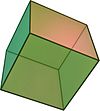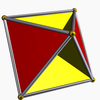Euler characteristic
In algebraic topology, the Euler characteristic is a topological invariant, a number that describes one aspect of a topological space's shape or structure. It is commonly denoted by .
The Euler characteristic was originally defined for polyhedra and used to prove various theorems about them, including the classification of the Platonic solids. Leonhard Euler, for whom the concept is named, was responsible for much of this early work. In modern mathematics, the Euler characteristic arises from homology and connects to many other invariants.
Polyhedra
The Euler characteristic was classically defined for polyhedra, according to the formula
where V, E, and F are respectively the numbers of vertices (corners), edges and faces in the given polyhedron. For any polyhedron homeomorphic to a sphere the Euler characteristic turns out to be
This result is known as Euler's formula. A proof is given below.
Examples of convex polyhedra
The surface of any convex polyhedron is homeomorphic to a sphere and therefore has Euler characteristic 2, by Euler's formula. This fact can be used to show that there are only five Platonic solids (regular polyhedra):
| Name | Image | V (vertices) | E (edges) | F (faces) | Euler characteristic: V − E + F |
|---|---|---|---|---|---|
| Tetrahedron | 
|
4 | 6 | 4 | 2 |
| Hexahedron or cube | 
|
8 | 12 | 6 | 2 |
| Octahedron | 
|
6 | 12 | 8 | 2 |
| Dodecahedron | 
|
20 | 30 | 12 | 2 |
| Icosahedron | 
|
12 | 30 | 20 | 2 |
Proof of Euler's formula

The first rigorous proof of Euler's formula, given by a 20-year-old Cauchy, is as follows.
Remove one face of the polyhedron. By pulling the edges of the missing face away from each other, deform all the rest into a planar network of points and curves, as illustrated by the first of the three graphs for the special case of the cube. (The assumption that the polyhedron is homeomorphic to the sphere at the beginning is what makes this possible.) After this deformation, the regular faces are generally not regular anymore — in fact, they are not even polygons. However, the numbers of vertices, edges and faces remain the same as those of the given polyhedron. (The removed face corresponds to the exterior of the network.)
If there is a face with more than three sides, draw a diagonal — that is, a curve through the face connecting two vertices that aren't connected yet. This adds one edge and one face and does not change the number of vertices, so it does not change the quantity V − E + F. Continue adding edges in this manner until all of the faces are triangular.
Apply repeatedly either of the following two transformations:
- Remove a triangle with only one edge adjacent to the exterior, as illustrated by the second graph. This decreases the number of edges and faces by one each and does not change the number of vertices, so it preserves V − E + F.
- Remove a triangle with two edges shared by the exterior of the network, as illustrated by the third graph. Each triangle removal removes a vertex, two edges and one face, so it preserves V − E + F.
Repeat these two steps, one after the other, until only one triangle remains.
At this point the lone triangle has V = 3, E = 3, and F = 2 (counting the exterior), so that V − E + F = 2. This equals the original V − E + F, since each transformation step has preserved this quantity. Therefore at the start of the process it was true that V − E + F = 2. This proves the theorem.
For additional proofs, see Nineteen Proofs of Euler's Formula. Multiple proofs, including their flaws and limitations, are used as examples in Proofs and Refutations by Imre Lakatos.
Examples of non-convex polyhedra
Non-convex polyhedra can have various Euler characteristics:
| Name | Image | V (vertices) | E (edges) | F (faces) | Euler characteristic: V − E + F |
|---|---|---|---|---|---|
| Tetrahemihexahedron | 
|
6 | 12 | 7 | 1 |
| Octahemioctahedron | 
|
12 | 24 | 12 | 0 |
| Cubohemioctahedron | 
|
12 | 24 | 10 | −2 |
Formal definition
The polyhedra discussed above are, in modern language, two-dimensional finite CW-complexes. (When only triangular faces are used, they are two-dimensional finite simplicial complexes.) In general, for any finite CW-complex, the Euler characteristic can be defined as the alternating sum
where denotes the number of cells of dimension in the complex.
More generally still, for any topological space, we can define the nth Betti number as the rank of the n-th homology group. The Euler characteristic can then be defined as the alternating sum
This quantity is well-defined if the Betti numbers are all finite and if they are zero beyond a certain index . This definition subsumes the previous ones.
Properties
Since the homology is a topological invariant (in fact, a homotopy invariant — two topological spaces that are homotopy equivalent have isomorphic homology groups), so is the Euler characteristic.
If M and N are any two topological spaces, then the Euler characteristic of their disjoint union is the sum of their Euler characteristics, since homology is additive under disjoint union:
More generally, if M and N are subspaces of a larger space X, then so are their union and intersection. The Euler characteristic obeys a version of the inclusion-exclusion principle:
Also, the Euler characteristic of any product space M × N is
These addition and multiplication properties are also enjoyed by cardinality of sets. In this way, the Euler characterstic can be viewed as a generalisation of cardinality; see [1].
As a corollary of Poincaré duality, the Euler characteristic of any closed odd-dimensional manifold is zero.
Relations to other invariants
The Euler characteristic of a closed orientable surface can be calculated from its genus g (the number of tori in a connected sum decomposition of the surface; intuitively, the number of "handles") as
The Euler characteristic of a closed non-orientable surface can be calculated from its non-orientable genus k (the number of real projective planes in a connected sum decomposition of the surface) as
For closed smooth manifolds, the Euler characteristic coincides with the Euler number, i.e., the Euler class of its tangent bundle evaluated on the fundamental class of a manifold. The Euler class, in turn, relates to all other characteristic classes of vector bundles.
For closed Riemannian manifolds, the Euler characteristic can also be found by integrating the curvature; see the Gauss-Bonnet theorem for the two-dimensional case and the generalized Gauss-Bonnet theorem for the general case.
A discrete analog of the Gauss-Bonnet theorem is Descartes' theorem that the "total defect" of a polyhedron, measured in full circles, is the Euler characteristic of the polyhedron; see defect (geometry).
Hadwiger's theorem characterizes the Euler characteristic as the unique (up to scalar multiplication) translation-invariant, finitely additive, not-necessarily-nonnegative set function defined on finite unions of compact convex sets in Rn that is "homogeneous of degree 0".
Examples
Any contractible space (that is, one homotopy equivalent to a point) has trivial homology, meaning that the 0th Betti number is 1 and the others 0. Therefore its Euler characteristic is 1. This case includes Euclidean space of any dimension, as well as the solid unit ball in any Euclidean space — the one-dimensional interval, the two-dimensional disk, the three-dimensional ball, etc.
The Euler characteristic can be calculated easily for general surfaces by finding a polygonization of the surface (that is, a description as a CW-complex) and using the above definitions.
| Name | Image | Euler characteristic |
|---|---|---|
| Sphere | 
|
2 |
| Torus | 
|
0 |
| Roman surface | File:Romansurface.jpg | 1 |
| Möbius strip | 
|
0 |
| Klein bottle | 
|
0 |
| Two spheres (not connected) |  
|
2 + 2 = 4 |
Partially ordered sets
The concept of Euler characteristic of a bounded finite poset is another generalization, important in combinatorics. A poset is "bounded" if it has smallest and largest elements; let us call them 0 and 1. The Euler characteristic of such a poset is defined as μ(0,1), where μ is the Möbius function in that poset's incidence algebra.















